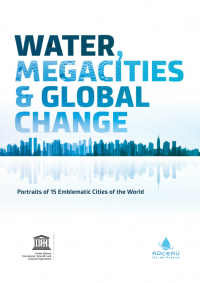Water, Megacities and Global Change: Portraits of 15 Emblematic Cities of the World
Published on by Water Network Research, Official research team of The Water Network in Academic
The international conference ‘Water, Megacities and Global Change’, organized at UNESCO Headquarters in December 2015 during COP21, shone a light on the key role that cities play in the achievement of the Sustainable Development Goals, especially Goal 6 of the 2030 Agenda, pertaining to universal access to water and sanitation.
 This overview of 15 emblematic cities, co-edited by UNESCO and ARCEAU-IdF, is simultaneously the result of concrete scientific presentations and a call for general mobilization to devise the sustainable urban policies the world needs.
This overview of 15 emblematic cities, co-edited by UNESCO and ARCEAU-IdF, is simultaneously the result of concrete scientific presentations and a call for general mobilization to devise the sustainable urban policies the world needs.
All these urban centres share a number of common characteristics: expansive size, disparities between rich and poor districts, environmental and industrial demand that strains the natural resources of an entire region – not to mention the economic weight of the country as a whole – and a wide range of cultural, scientific and educational resources.
In 1970, the United Nations identified three megacities. This number rose to 10 in 1990 and 28 in 2014. According to projections, there will be 41 by 2030, many located in the world’s least developed countries.
Throughout history, these cities have often lacked both the time and the means to develop their urban services, including those relating to access to water, sanitation and rainwater drainage. This situation creates profound vulnerabilities and complex challenges.
It is crucial that megacities share their experiences, so as to develop services capable of meeting the expectations of their inhabitants. Inclusive management of water resources is also the solution to a variety of social challenges, in particular, gender inequalities, as women are frequently worst hit by difficulties gaining access to water, and are on the front line when it comes to better resources management.
This book marks an important phase in the creation of an alliance of megacities focused on waterrelated issues in the face of climate change. UNESCO is strongly implicated in this process through its International Hydrological Programme (IHP). Cooperation for and surrounding water needs to take place at all levels – between governments, between and within societies, and at the heart of cities.
Megacities embody the principal of ‘creative constraint’, whereby infinitely complex situations engender the mobilization of an incredible number of talents, experts and initiatives to provide solutions. In this new era of limited resources, human ingenuity and respect for each other’s dignity represent our ultimate renewable resources. We need to free their potential. When all is said and done, the strength of a city comprises its capacity to assemble talents and create an environment of diversity in which men and women can work together to build a sustainable future.
Irina Bokova, Director-General of UNESCO.
Taxonomy
- Integrated Urban Water Management
- Access
- Water Supply
- Urban Water Infrastructure
- Urban Design
- Sustainable Development